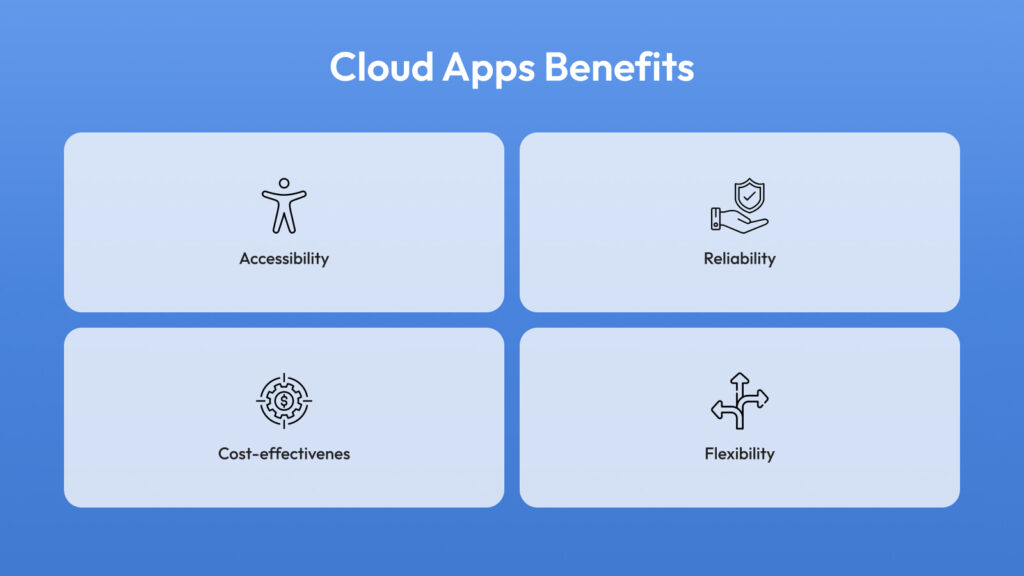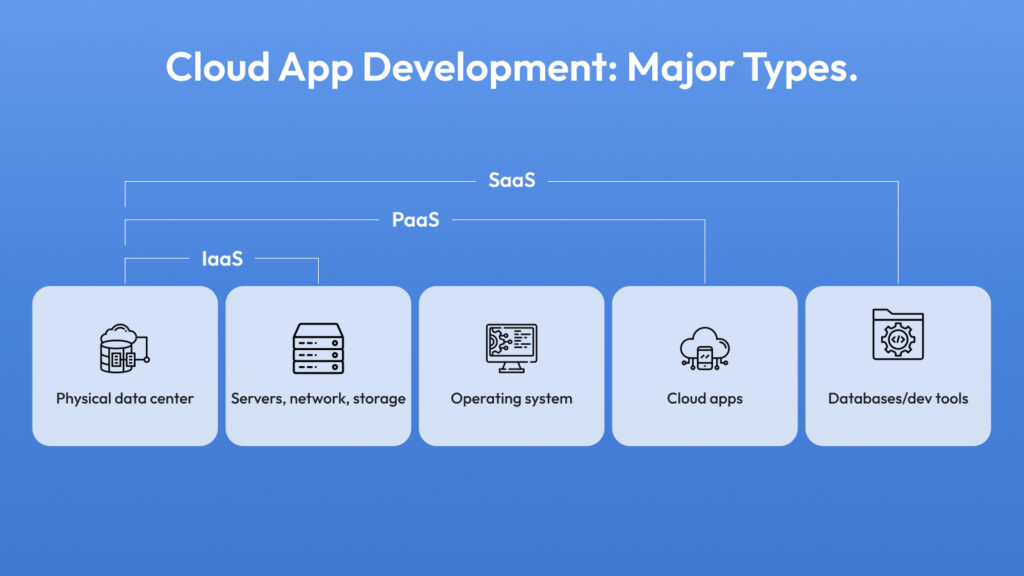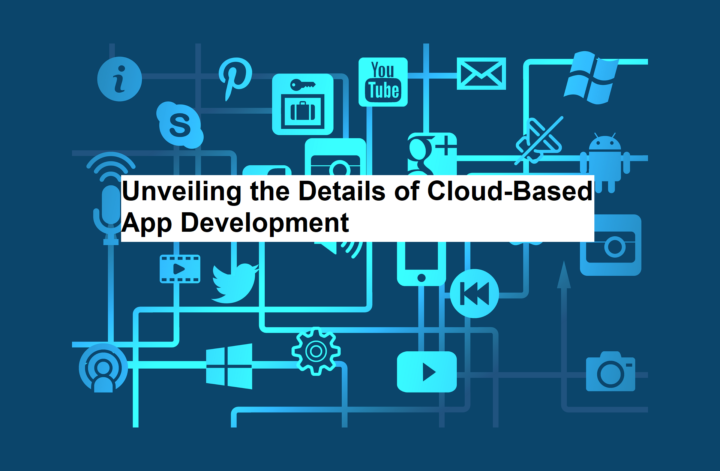Businesses increasingly employ cloud-based solutions for their scalability, flexibility, and efficiency. However, building such software differs from traditional software, which is important to comprehend to guarantee project success. In this article, we’ll take a closer look at the fundamental technological concerns you should assume when planning to build your cloud application.
Join us to dive into the intricacies of cloud application development and explore its many benefits, diverse service models, and transformational potential in today’s dynamic business landscape.
What Is Cloud Application Development and Why Invest in It?

Cloud application development involves creating software solutions in a cloud environment utilizing cloud services for operations such as data storage and processing. This method provides developers with greater opportunities and integration capabilities to innovate and create web-based solutions that enhance the user experience.
Enterprises often choose cloud services because of their benefits for optimizing business processes, such as:
- Availability. Cloud-based apps are convenient for users from anywhere without being tied to a physical device, making remote work easier.
- Reliability. Storing all critical information in the cloud ensures that important data is saved in cases of unforeseen technical infrastructure failures.
- Cost-effectiveness. When moving processes to the cloud, companies can save 10-40% in operating costs by eliminating significant hardware, software, and corresponding supervision and upgrade expenses.
Flexibility. Cloud-based applications can scale up and down according to the business’s current needs, minimizing downtime and increasing efficiency.
Exploring Common Types of Cloud-Based Apps
Cloud-based applications are incredibly diverse and designed to meet various industry needs and requirements. Let’s delve deeper into some of the most common types:
Software as a Service (SaaS)
Software as a Service enables companies to design and utilize cloud-based applications that users can access online from any device without needing installation or customization. With this flexibility and accessibility, SaaS is becoming increasingly widespread among companies looking to streamline operations and increase efficiency. Whether it’s document management, project collaboration, tracking customer data, or automating processes, SaaS includes various solutions that fulfill the diverse demands of modern businesses.
Platform-as-a-Service (PaaS)
PaaS involves the instruments to produce and launch cloud-based applications without facing the intricacies of handling the underlying infrastructure. With PaaS, developers can rent everything they require to create cloud applications from a single vendor, including development tools, middleware, operating systems, and hardware resources. This makes developing applications in the cloud much easier and more efficient, as developers can focus on writing code and creating innovative solutions without setting up and maintaining the infrastructure.
Infrastructure as a Service (IaaS)
An IaaS cloud service vendor supplies servers, networking, visualization, and data storage in a public or private cloud. Thus, businesses can focus on their primary activities without wasting time and resources on technical details. IaaS providers provide many services beyond infrastructure management, including resiliency tools for backup and recovery, security tools for data encryption and compliance, detailed billing, log access, tracking, clustering, and load balancing.
Key Technical Aspects of Cloud Development

Let’s take a look at the key technical features to consider when developing cloud applications:
- Scalability. To ensure your cloud application can scale later, you should plan and architect the solution to accommodate future enhancements.
- Security. Cloud application development requires top-notch security measures to protect against data breaches and cyberattacks. Encryption, role-based access control, and regular security updates are key to ensuring data protection in the cloud.
- Seamless integration. Seamless integration with other business systems is important to the success of cloud applications. To ensure robust integration, ensure data standardization, verify current systems are up to date, and make changes as needed.
- Performance monitoring and management. Monitoring performance, resource utilization, and user experience helps identify problems early to avoid downtime. Performance tracking and testing tools help improve application efficiency and reliability.
- Budget planning. To optimize costs, monitor resource usage, select cost-effective services, and manage resources efficiently. Use cloud service cost management tools to track expenses and find ways to save money.
Read: The Benefits of Implementing Smart Chatbots for Your Business
Steps to Develop a Cloud Application
To build a cloud app, you should carefully work on such development stages:
Idea validation
Start with analyzing and refining your idea to ensure the project’s success and longevity. Decide on who is your target audience, what are their pains and needs you aim to address, and how your cloud solution can help them. Next, analyze your current competitors to learn from their examples.
Choose the IT partner
Your next step on the cloud app development journey is finding and hiring a reliable software development company to work on your product. You can hire an in-house cloud development team, but in this case, you should be prepared for extra expenses, including rent, hardware costs, and salaries. On the other hand, you can turn to an outsourcing cloud development vendor to provide you with the specialists you need at a lower cost. Moreover, outsourcing development allows you to save time on hiring.
Clarify project requirements
Your partnership with software developers should start by clarifying and detailing the requirements for your cloud app. Decide on the type of cloud services, functional and non-functional requirements, UI/UX design features, etc. This step also involves working on the first design prototypes and concepts, which will be improved after your approval and passed on to developers.
Development and testing
After all requirements are defined, developers start building your cloud applications. They create its functionality stage by stage while QA engineers perform various tests to ensure everything works properly. Moreover, developers integrate your cloud applications with the current business infrastructure and check if everything works correctly.
Deployment
Deploying cloud-based applications involves setting up the application on the selected cloud platform, ensuring it runs smoothly in a production environment. This process includes configuring servers, databases, and networking components, followed by rigorous testing to ensure everything functions correctly. Deployment is critical for making the application accessible to users and typically involves monitoring the process to catch and fix any issues quickly.
Maintenance
Ongoing maintenance is essential for keeping the cloud application secure, efficient, and up-to-date. This includes applying software updates, patching security vulnerabilities, optimizing performance, and scaling resources as needed. Regular maintenance ensures the application meets user needs and operates reliably over time.
Summarizing
Cloud app development requires attention to technical factors such as scalability, security, integration, monitoring, performance, and cost optimization, making it challenging but ultimately beneficial. Cloud technology and best practices can enhance business application development, leading to more innovative and competitive solutions in the digital economy. Organizations can benefit from cloud computing and reduce SaaS development costs by leveraging effective tools, techniques, and expertise to add value for their customers and stakeholders.




